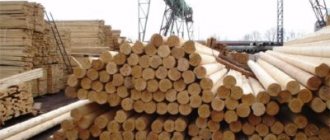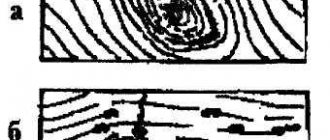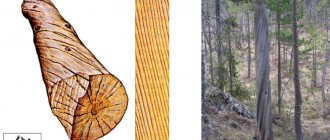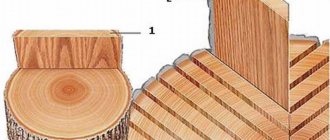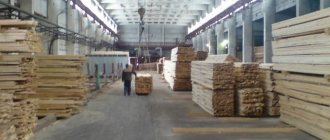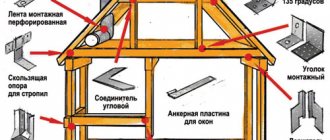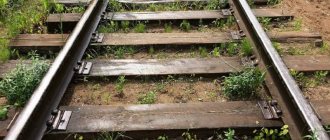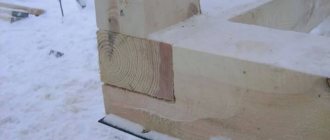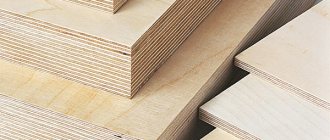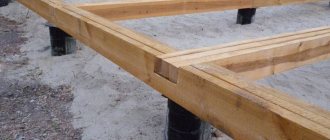What it is?
In a professional environment, timber products are wood blanks in which the original physical and chemical structure has been preserved; in everyday speech they also include lumber. To obtain timber the following is used:
- industrially felled trees;
- hand felled timber;
- suitable species of self-fallen trees (rare);
- whips and their parts.
In the process of timber production, various options for division in the transverse or longitudinal plane are used. We are talking primarily about the following processes:
- sawing;
- planing;
- processing with cutters;
- schism;
- peeling;
- crushing (grinding).
It is worth noting that timber products cannot be mixed with secondary whole products, for example, the following:
- with laminated timber;
- with different types of plywood;
- with chipboard, fibreboard, MDF.
The most important advantages of timber are, of course, their natural origin and ease of use in various cases. And also in favor of such a product is its accessibility to consumers. Wooden structures last a long time and are stable. When used correctly, this material is not too inferior to brick and concrete in terms of durability. The aesthetic flavor of anything made from timber is also very important.
But wood has more than just benefits. The disadvantages include:
- high flammability;
- susceptibility to dampness and mold (removable, but valuable environmental properties are lost during processing);
- tendency to absorb moisture in large quantities;
- high risk of shrinkage, warping and other similar deviations that provoke deformation of building structures;
- difficulties in choosing the appropriate species and category of timber.
Types of timber
The trunks of deciduous or coniferous trees, with branches and knots removed and sawn across, are round lumber. The bark on them can be removed. The thickness varies. Also, their purpose may be different. There are 4 groups of round timber.
- Materials for peeling and planing.
- Materials for sawing.
- Materials for processing and producing wood pulp and cellulose.
- Materials for use without sawing, i.e. in round form.
The production of round timber is carried out with the aim of obtaining lumber. Softwood roundwood is primarily a raw material for lumber production.
What is wood waste?
Wood waste refers to any materials that are obtained as a result of forest maintenance or commercial wood processing, but are not the final product. Therefore, waste can be either whole trees or any fragments that remain after they are cut down or processed.
Most often, waste is classified as:
- tree trunks cut down during site clearing;
- branches cut from trunks;
- stumps left in the ground;
- bark;
- croaker;
- all kinds of trimmings;
- fallen leaves;
- sawdust;
- shavings;
- wood chips
Types of lumber
Lumber is divided into:
- Plates representing a half log that has been sawn along the stem axis.
- Wood quarters obtained by sawing a log along two diameters, which are mutually perpendicular to each other, into 4 parts.
- The bars are more than 10 cm thick and wide.
- Wooden sleepers - look like timber with a large cross-section. Designed mainly for laying under railway rails.
- Boards – up to 10 cm thick, no more than 20 cm wide.
- Bars - lumber less than 10 cm thick, up to 20 cm thick.
- Croakers are waste obtained from sawing the side of logs.
- Planks are lumber having a thickness of 6 to 8 cm and a width of 10 to 16 cm.
- Flat slats - thin wooden boards, bars.
Grade
Based on quality characteristics, timber is divided into four grades. When establishing the grade, the whip is divided into the butt, middle and apical parts. Butt wood has the highest physical and mechanical properties and does not have live knots on the side surface. In the middle part of the whip there is the largest number of overgrown and tobacco knots. The apical part is most abundant in healthy knots of different sizes.
- 1st grade: large-sized assortment from the butt part of the whip. Knot-free or low-knot logs are used for the production of wood materials for special purposes: aircraft, deck, veneer, etc.
- 3rd grade: such timber can be obtained from any part of the log. They are used both in round and sawn form. They are used in mechanical engineering and construction; they are used to make sleepers, railway transfer bars, and furniture. In coniferous timber, the number of healthy knots is not taken into account.
- 4th grade: used for lumber for construction, mechanical engineering, furniture, packaging. External rotten rot, the simultaneous presence of sapwood and heart rot in coniferous and sapwood deciduous species (birch, alder, hornbeam, maple), and heart rot in thin assortments of all species are not allowed[1].
What is the difference between timber and sawn timber?
Sometimes the terms lumber and timber are used interchangeably. But in fact the difference is significant. Lumber - finished wood products. Timber products are semi-finished products that require further deep processing. These are blanks that are often used as consumable raw materials for the manufacture of lumber.
Lumber and timber are actively used in construction. But in order to get a reliable and high-quality structure, you need to choose the right material. When purchasing, it is recommended to require quality certificates.
Lumber range
Lumber is sawn timber. Their shapes and sizes may vary. Depending on these indicators, lumber is distinguished as boards, sleepers, beams, beams, plates, slabs, etc. Each type of such blanks has its own purpose.
A range of lumber is a specific classification. All lumber is divided into different groups depending primarily on size. At the same time, other consumer characteristics of wood raw materials are also taken into account. It is assessed in accordance with currently valid GOSTs for such products. Industrial wood is a raw material for construction. It is used in the form of lumber or logs. Thus, GOST 24454-80 classifies all types of wood by weight, dimensions, and moisture content.
Sleepers are used for the construction of railways. They are beams with a wide cross section. Boards are used in the construction of residential buildings and outbuildings, as well as other areas of industry. Their sizes may vary. The thickness of the board is at least 10 cm, the width must be greater than twice the thickness. Plates are logs sawn lengthwise. Quarters are cuts along two perpendiculars. Bars are materials with a width and thickness of more than 10 cm. Bars have a thickness of less than 10 cm, and their width is less than double the thickness. When cutting logs into boards or bars, waste remains on the sides, which are called slabs. Also used are slats - narrow and thin boards, and planks - sawn materials 12–16 cm wide and 6 to 8 cm thick.
Timber products are divided into steep - logs and sawn - lumber. Logs are parts of a tree trunk with sawn ends and cleared of knots. Dimensions and technical requirements for round timber are given in GOST 9463-88. Depending on quality, round timber is divided into 1st, 2nd and 3rd grades.
Logs have a natural decrease in diameter along the length of the trunk, called a runoff. The diameter of round timber is determined by the diameter of the thin end. According to their diameter, logs are divided into groups: small (podtovarnik) with a diameter of less than 14 cm; medium diameter 14...24 cm with gradation every 2 cm; large ones with a diameter of over 26 cm with a gradation of 2 cm. Calibrated logs with a constant diameter along the length are also produced. Logs for construction have a standard length from 3.0 to 6.5 m with gradation every 0.5 m. Longer logs are prepared by special order for power line supports. Round timber is used as rafters, power transmission line supports, piles, and is also used in the construction of temporary structures and scaffolding.
Lumber is obtained by sawing round timber on saw frames or circular saws. Lumber is divided according to the nature of processing: edged (sawn on 4 sides along the entire length); wane (part of the surface is not sawn along the entire length due to the run-off of the log); unedged (two edges are not sawn).
Rectangular lumber is divided into boards (the face is twice the size of the edge), bars (the ratio of the face to the edge is less than two) and beams (the dimensions of the face and edge are more than 100 mm). The wide side of the board is called the face, the narrow side is called the edge, and the line of their intersection is called the edge.
Technical requirements for lumber are given in GOST 8486-86*E. Based on the quality of wood and processing, boards and bars are divided into five grades (selected, 1.2, 3.4), and beams into four grades (1.2, 3, 4).
READ Sleeper manufacturing technology
The dimensions of lumber are given in GOST 244454-80*E: the length of lumber is from 1 to 6.5 m with gradation every 0.25 m, thickness and width are given in table. 2.1.
GOST 24454-80 Softwood lumber. Dimensions
Flats are opposite surfaces of quadrangular cuts with a large width. The boards have two sides. Bars, square blanks - four faces each, i.e. all opposite surfaces are faces. The planes are distinguished between tangential, radial and mixed. This is determined by their relationship to the arrangement of growth rings in the tree trunk. The tangential layer is located away from the middle and near the growth rings. Radial - at a distance from them, wood fibers run longitudinally in it. Mixed - the location of the growth rings when sawing a log is not taken into account. The highest quality and most valuable are lumber with radial facets, but they require significantly higher costs and their production leaves more waste.
Edges are the longitudinal surfaces of the narrow side (boards, etc.). The angle between the face and the edge is called an edge.
Lumber is processed in different ways. And depending on the method used, they are divided into unedged, one-sided edged and edged. When processing even one tree trunk or log, boards are obtained that are not identical in their production characteristics and quality. According to their location in the cut (tree trunk), namely in relation to its axis, they are divided into lateral, central, core and slabs.
Side boards are called boards obtained from the side part of a tree trunk (log). They lend themselves well to processing, their surface is usually clean and smooth, with few knots. Core are boards containing a core layer of wood. They are cut mainly from thick logs. The thickness of such boards is more than 4 cm. Central boards are made from the central part of the log. The core layer is sawn lengthwise and all the annual rings of the trunk are cut. Cracks rarely appear in them. Croakers are boards sawn on one side. They are considered waste after cutting logs. They are used for processing and producing other materials.
Characteristics of timber
Timber is obtained by cutting tree trunks lengthwise or crosswise, depending on further use. Wood that has retained its chemical composition and physical natural structure unchanged is called timber. A cut trunk, from which branches and roots have been removed, is called a tree whip in the language of specialists. Cutting a tree trunk into separate sections is called bucking. And the segments themselves are called ridges. According to their diameter, such segments are divided into logs, side products and poles. The first of them have a diameter of at least 12 cm, the second - 8-11 cm, and the third - 3-7 cm. Such timber is obtained by sawing a log.
According to currently accepted standards, tree sticks can fall into one of two categories. Based on quality, as well as the presence or absence of defects and blemishes, they are rated as industrial and firewood. High-quality wood, called industrial wood, is used for construction purposes. Low-quality or firewood wood primarily serves as raw material for technological processing.
Various methods of processing timber are used, which determine their belonging to one of 6 classes:
- sawn;
- round;
- planed;
- peeled;
- chopped.
All timber of the specified classes, processed by one of these methods, are called assortments. The last (sixth) class is crushed lumber. They are obtained by processing wood using special equipment.
General information about lumber
Products of various types obtained by cutting tree trunks are usually called lumber. Depending on the type of tree, it can be coniferous or deciduous. Pine, spruce and larch logs are used to make coniferous materials. The most popular hardwood materials are birch, oak and aspen. Various defects arise in a growing tree due to climatic conditions and a number of other reasons. Therefore, wood brought from the forest almost always has defects (cracks, knots) that reduce the quality.
Depending on the number of various defects (in appearance and characteristics), the grade of wood is determined. In addition to raw trunks, dead wood is also sawn into lumber - dried but standing trees. Building material made from dead wood is best suited for the construction of wooden houses. In fairness, we must admit that all building materials have advantages and disadvantages. Alas, timber made from dead wood is no exception; it also has its pros and cons. The main disadvantage of such timber is considered to be high cost, since it is classified as an elite building material. For this reason, many developers cannot afford it.
Lumber used in the construction of houses is subject to fairly stringent requirements. They concern not only individual characteristics (sizes, shapes), but also the number of defects, as well as the level of humidity. The grade of wood depends on several parameters that are strictly regulated by the state standard; GOST 2140-81 contains a similar description of them.
When constructing a house, timber and lumber of the first or second grade, manufactured in accordance with GOST, are used. Most often these are types of coniferous wood, which have many advantages. For example, the high strength of materials is of great importance when constructing a frame. Meanwhile, soft pine wood is easier to process because it is very pliable. Hardwood is used mostly for making furniture. For example, solid beech woods are best suited for Viennese chairs.
GOST lumber - what does it mean
In Russia, rich in timber reserves, edged boards and four-edged timber will always be in demand as building materials.
But in order to buy high-quality lumber, the developer needs to be very careful in choosing a responsible supplier and have at least a little understanding of the basic characteristics of lumber products.
Next, we will look at how GOST edged lumber differs from low-quality products.
The production of lumber in our country is regulated by regulatory documents that were adopted back in the middle of the second half of the twentieth century. Participants in the domestic market use more than two dozen quite current GOSTs for coniferous and deciduous species, which allows the consumer to interact normally with manufacturers and suppliers.
The task of the GOST system in this area is to formulate clear rules for determining product quality, establish requirements for the production, storage, transportation and sale of a specific product. The most popular for determining the quality of edged softwood lumber are:
This lumber is GOST
State standard 8486-86 in detailed tables describes the defects and defects of lumber with a moisture content of up to 22 percent (or wet antiseptic).
It contains all the information to determine, based on specific criteria, which of the 5 categories (selected + 4 grades) an edged board/timber made of pine or spruce belongs to.
The document not only lists the defects that determine the grade, but also indicates their permissible size, quantity, type...
Defects of wood according to GOST 2140-81
Defects of wood according to GOST 2140-81 Norms for limiting defects in lumber for selected grades 1st 2nd 3rd 4th
| 1. Knots | ||||||||||
| 1.1. Healthy fused, and in bars and partially fused and non-fused healthy: | Allowed in size in fractions of the side width and in quantity on any one-meter length on each side, not more than: | |||||||||
| Size | Quantity, pcs. | Size | Quantity, pcs. | Size | Quantity, pcs. | Size | Quantity, pcs. | Size | Quantity, pcs. | |
| Slab and rib | 1/5 | 2 | 1/4 | 3 | 1/3 | 4 | 1/2 | 4 | Allowed | |
| Edgebanding: on lumber up to 40 mm thick | 1/3 | 1 | 1/2 | 2 | 2/3 | 2 | Full edge | 2 | Allowed | |
| Thickness 40 mm or more | 1/4, but not more than 15 mm | 2 | 1/3 | 2 | 1/2 | 3 | Full edge | 3 | Allowed | |
| 1.2. Partially fused and unfused | Allowed in the total number of fused healthy knots in size in fractions of the width of the side and in quantity on any one-meter section of length on each side, no more than: | |||||||||
| Size | Quantity, pcs. | Size | Quantity, pcs. | Size | Quantity, pcs. | Size | Quantity, pcs. | Size | Quantity, pcs. | |
| face and rib | 1/8 | 2 | 1/5 | 2 | 1/4 | 3 | 1/3 | 3 | 1/2 | 4 |
| edging: on lumber up to 40 mm thick | 1/4 | 1 | 1/3 | 1 | 1/2 | 2 | Full edge | 2 | Full edge | 2 |
| thickness 40 mm or more | 10 mm | 1 | 1/4 | 2 | 1/3 | 2 | 2/3 | 2 | Same | 3 |
| 1.3. Rotten, rotten and tobacco | Not allowed | Allowed in the total number of partially fused and unfused healthy knots of the same size and no more than half of their number | ||||||||
| The wood surrounding the tobacco knots should not show signs of rot. |
What is commercial timber?
These wood-based panels (chipboard, fiberboard) can be made from fibers, shavings, sawdust and other sawmill waste. And for the manufacture of solid wood furniture, the raw material can only be high-quality industrial wood. This category includes raw materials made from the stem part of a tree. Of the total volume of logging, the yield of industrial wood is 72-85% (depending on the species and age of the trees).
The fibrous structure of the trunk can be studied from three main sections:
- end (transverse) - a cut across the fibers, perpendicular to the stem axis;
- radial - passing through the core of the barrel, at right angles to the end;
- tangential - applied parallel to the axis (at any distance from the core), tangential to the annual layers.
When a cross section of the trunk is made, the following layers are distinguished:
- bark, cork and bast layer - external protection of the tree;
- cambium - a thin layer between the sapwood and bark;
- sapwood - porous wood through which water and nutrients rise up the trunk from the roots to the crown;
- core (which includes the core);
- medullary rays;
- annual circles.
Which lumber does not need to be registered in EGAIS Forest
Let's consider which lumber does not fall under the Unified State Automated Information System in 2021:
- profiled;
- unprocessed (for example, logs);
- carpentry (building parts and assembly elements made of wood);
- prefabricated wooden structures (for example, furniture);
- plywood (composite material made from natural wood);
- particle board (chipboard) - a composite material in the form of a sheet made by hot pressing of wood particles, mainly shavings, mixed with a binder of non-mineral origin);
- wooden containers (boxes, cartons, etc.);
- wood flour, shavings, wood chips.
Profiled lumber is a high-tech building material, made in most cases from softwood. It differs from laminated veneer lumber in that the entire structure inside the tree is not damaged. Profiled solid timber “breathes” and is considered more environmentally friendly.
However, unlike laminated veneer lumber, profiled lumber is subject to greater shrinkage, deformation and cracking. Unfortunately, the state does not specifically define which materials are classified as profiled. The identity of the wood is determined by its characteristic features.
As for the painted material and treated with antiseptics, it also falls into the list of wood that is not subject to registration in the Unified State Automated Information System (despite the fact that it is included in the list of those subject to registration). It's all about the degree of coloring and processing.
